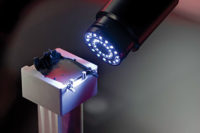Planar Flat Candle's lamps need to last 40,000 hours in mission critical applications. The company requires components, such as the wire filaments, to be just as reliable. Numerous wire suppliers did not want to supply Planar Flat Candle with test samples or did not meet the company's standards. According to John Blessing, manufacturing manager at Planar Flat Candle, "Testing was essential because we had to find wire that could stand up under high voltage."
To make a cold cathode-type lamp for backlighting, a wire less than the thickness of a pencil lead is inserted into a glass envelope. Current passes through an electrode, through a gas cavity in the envelope, to the other electrode, creating gas plasma that excites a phosphor coating, illuminating the lamp.
"To get the longevity we needed in a lamp, the wire had to repeatedly carry 800 to 1,200 volts in a sealed vacuum of about 16 torr. Most of the wire we tested disintegrated under that kind of voltage in a vacuum," says Blessing. The workfunction of wire, or its durability under current, was also important to the company.
The wire that was tested sputtered or threw off material when voltage exceeded the wire's workfunction. When the wire fails, so does the lamp, Blessing says. Through industry sources, Planar Flat Candle found California Fine Wire (CFW, Grover Beach, CA), manufacturer of specialty wire products for industrial, military and scientific applications.
CFW supplied Planar Flat Candle with the sample wire it needed. Blessing says that access to a vari-ety of specialty dies, which is where a wire is drawn or stretched out, is particularly important in meeting design tolerances, which prevent component failures, such as sputtering wire filament. With over 25,000 different dies, CFW was able to exceed Planar Flat Candle's specified diameter tolerance to 0.0003 inch with tolerance to 0.00015 inch.
Die quality is also important in producing consistent, reliable wire because any defect can produce unacceptable scratches or blemishes in the finished product. For Planar Flat Candle, the wire had to have a flawless surface in order to operate in temperatures up to 2,100 F. Surface imperfections, such as scratches or protrusions, interrupt the flow of current, causing the wire to slowly disintegrate.
To prevent sputtering, CFW uses an ultrafinish on the surface of the wire, which is applied by using a die polished by powdered diamonds less than 0.5 micron in diameter. The surface is like a polished mirror, so electric current flows evenly, thus preventing sputtering.
Because consistency and tight tolerances are essential when dealing with mission critical components, CFW says that it checks the wire for size, surface quality, resistance, tensile strength and electrical properties up to 50 times before shipping to Planar Flat Candle.
"We have doubled our output in the last two years," says Blessing. "CFW supplied high-quality wire when we needed it, which helped us grow."
California Fine Wire
(805) 489-5144
www.calfinewire.com
